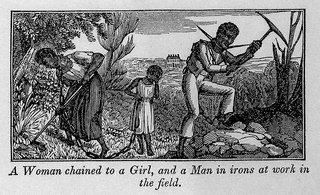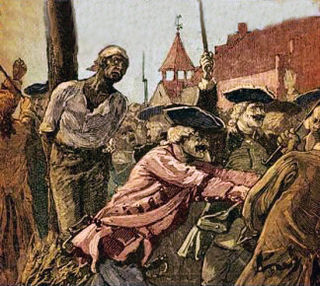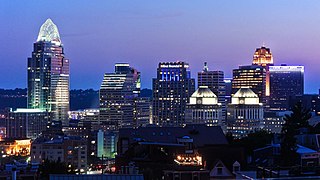Related Research Articles
In the broader context of racism in the United States, mass racial violence in the United States consists of ethnic conflicts and race riots, along with such events as:

Wilberforce University is a private historically black university in Wilberforce, Ohio. Affiliated with the African Methodist Episcopal Church (AME), it was the first college to be owned and operated by African Americans. It participates in the United Negro College Fund.

Austin Steward was an African-American abolitionist and author. He was born a slave in Virginia then moved at age 7 with the Helm household to New York State in 1800. The household settled in the town of Bath, New York, in 1803. He escaped slavery at about age 21, settling in Rochester, New York, and then British North America. His autobiography, Twenty-Two Years a Slave, was published in 1857.

African American history started with the arrival of Africans to North America in the 16th and 17th centuries. Former Spanish slaves who had been freed by Francis Drake arrived aboard the Golden Hind at New Albion in California in 1579. The European colonization of the Americas, and the resulting Atlantic slave trade, led to a large-scale transportation of enslaved Africans across the Atlantic; of the roughly 10–12 million Africans who were sold by the Barbary slave trade, either to European slavery or to servitude in the Americas, approximately 388,000 landed in North America. After arriving in various European colonies in North America, the enslaved Africans were sold to white colonists, primarily to work on cash crop plantations. A group of enslaved Africans arrived in the English Virginia Colony in 1619, marking the beginning of slavery in the colonial history of the United States; by 1776, roughly 20% of the British North American population was of African descent, both free and enslaved.

The Conspiracy of 1741, also known as the Slave Insurrection of 1741, was a purported plot by slaves and poor whites in the British colony of New York in 1741 to revolt and level New York City with a series of fires. Historians disagree as to whether such a plot existed and, if there was one, its scale. During the court cases, the prosecution kept changing the grounds of accusation, ending with linking the insurrection to a "Popish" plot by Spaniards and other Catholics.

The history of the state of Mississippi extends back to thousands of years of indigenous peoples. Evidence of their cultures has been found largely through archeological excavations, as well as existing remains of earthwork mounds built thousands of years ago. Native American traditions were kept through oral histories; with Europeans recording the accounts of historic peoples they encountered. Since the late 20th century, there have been increased studies of the Native American tribes and reliance on their oral histories to document their cultures. Their accounts have been correlated with evidence of natural events.

Cincinnati began with the settlement of Columbia, Losantiville, and North Bend in the Northwest Territory of the United States beginning in late December 1788. The following year Fort Washington, named for George Washington, was established to protect the settlers.

Lewis Woodson was an educator, minister, writer, and abolitionist. He was an early leader in the African Methodist Episcopal Church (AME) in Ohio and Pennsylvania. Woodson started and helped to build other institutions within the free African-American communities in Ohio and western Pennsylvania prior to the American Civil War.
The 1943Detroit race riot took place in Detroit, Michigan, from the evening of June 20 through to the early morning of June 22. It occurred in a period of dramatic population increase and social tensions associated with the military buildup of U.S. participation in World War II, as Detroit's automotive industry was converted to the war effort. Existing social tensions and housing shortages were exacerbated by racist feelings about the arrival of nearly 400,000 migrants, both African-American and White Southerners, from the Southeastern United States between 1941 and 1943. The migrants competed for space and jobs against the city's residents as well as against European immigrants and their descendants. The riot escalated after a false rumor spread that a mob of whites had thrown a black mother and her baby into the Detroit River. Blacks looted and destroyed white property as retaliation. Whites overran Woodward to Veron where they proceeded to violently attack black community members and tip over 20 cars that belonged to black families.
Wilberforce Colony was a colony established in the year 1829 by free African American citizens, north of present-day London, Ontario, Canada. It was an effort by American Blacks to create a place where they could live in political freedom.

Mississippi is a state in the Southeastern region of the United States, bordered to the north by Tennessee; to the east by Alabama; to the south by the Gulf of Mexico; to the southwest by Louisiana; and to the northwest by Arkansas. Mississippi's western boundary is largely defined by the Mississippi River, or its historical course. Mississippi is the 32nd largest by area and 35th-most populous of the 50 U.S. states and has the lowest per-capita income in the United States. Jackson is both the state's capital and largest city. Greater Jackson is the state's most populous metropolitan area, with a population of 591,978 in 2020.

Cincinnati is a city in and the county seat of Hamilton County, Ohio, United States. Settled in 1788, the city is located in the northern side of the confluence of the Licking and Ohio rivers, the latter of which marks the state line with Kentucky. The city is the economic and cultural hub of the Cincinnati metropolitan area and has an estimated population of 2,265,051. The city is Ohio's largest metropolitan area and the nation's 30th-largest city. The population of Cincinnati is 309,317 which makes the city the third-most populous city in Ohio after Columbus and Cleveland, and 65th in the United States.
The Detroit race riot of 1863 occurred on March 6, 1863, in the city of Detroit, Michigan, during the American Civil War. At the time, the Detroit Free Press reported these events as "the bloodiest day that ever dawned upon Detroit." It began due to unrest among the working class related to racism and the military draft, which was heightened after the Emancipation Proclamation was issued by President Abraham Lincoln. Based in a free state, some recent immigrants and other workers resented being drafted for a war that they thought was waged for the benefit of slaves in the Southern United States, and they feared competition from Black people.
The Cincinnati riots of 1836 were caused by racial tensions at a time when African Americans, some of whom had escaped from slavery in the Southern United States, were competing with whites for jobs. The racial riots occurred in Cincinnati, Ohio, United States in April and July 1836 by a mob of whites against black residents. These were part of a pattern of violence at that time. A severe riot had occurred in 1829, led by ethnic Irish, and another riot against blacks broke out in 1841. After the Cincinnati riots of 1829, in which many African Americans lost their homes and property, a growing number of whites, such as the "Lane rebels" who withdrew from the Cincinnati Lane Seminary en masse in 1834 over the issue of abolition, became sympathetic to their plight. The anti-abolitionist rioters of 1836, worried about their jobs if they had to compete with more blacks, attacked both the blacks and white supporters.

The Cincinnati riots of 1841 occurred after a long drought had created widespread unemployment in Cincinnati, Ohio, United States. Over a period of several days in September 1841, unemployed whites attacked black residents who defended themselves. Many blacks were rounded up and held behind a cordon and then moved to the jail. According to the authorities, this was for their own protection.
African Americans are the second largest census "race" category in the state of Tennessee after whites, making up 17% of the state's population in 2010. African Americans arrived in the region prior to statehood. They lived both as slaves and as free citizens with restricted rights up to the Civil War.
The Metro Detroit region of Michigan is home to a significant Appalachian population, one of the largest populations of Urban Appalachians in the United States. The most common state of origin for Appalachian people in Detroit is Kentucky, while many others came from Tennessee, West Virginia, Virginia, Ohio, and elsewhere in the Appalachia region. The Appalachian population has historically been centered in the Detroit neighborhoods of Brightmoor, Springwells, Corktown and North Corktown, as well as the Detroit suburbs of Hazel Park, Ypsilanti, Taylor, and Warren. Beginning after World War I, Appalachian people moved to Detroit in large numbers seeking jobs. Between 1940 and 1970, approximately 3.2 million Appalachian and Southern migrants settled in the Midwest, particularly in large cities such as Detroit and Chicago. This massive influx of rural Appalachian people into Northern and Midwestern cities has been called the "Hillbilly Highway". The culture of Metro Detroit has been significantly influenced by the culture, music, and politics of Appalachia. The majority of people of Appalachian heritage in Metro Detroit are Christian and either white or black, though Appalachian people can be of any race, ethnicity, or religion.
Black Kentuckians are residents of the state of Kentucky who are of African ancestry. The history of Blacks in the US state of Kentucky starts at the same time as the history of White Americans; Black Americans settled Kentucky alongside white explorers such as Daniel Boone. As of 2019, according to the U.S. Census Bureau, African Americans make up 8.5% of Kentucky's population. Compared to the rest of the population, the African American census racial category is the 2nd largest.
Black Laws of 1804 and 1807 discouraged African American migration to Ohio. Slavery was not permitted in the 1803 Constitution. The 1804 law forbade black residents in Ohio without a certificate they were free. The 1807 law required a $500 bond for good behavior.
References
- 1 2 "Irish Ohioans". Ohio History Central. Ohio Historical Society. Retrieved 2010-10-28.
- ↑ Irvine, Russell W.; Dunkerton, Donna Zani (Winter 1998). "The Noyes Academy, 1834-35: The Road to the Oberlin Collegiate Institute and the Higher Education of African-Americans in the Nineteenth Century". Western Journal of Black Studies. 22 (4): 260–273.
- ↑ Nikki Marie Taylor (2005). Frontiers of Freedom: Cincinnati's Black Community, 1802-1868. Ohio University Press. p. 50ff. ISBN 0-8214-1579-4 . Retrieved 2010-10-28.
- ↑ Nikki Marie Taylor, Frontiers of Freedom: Cincinnati's Black Community, 1802-1868, Columbus: Ohio University Press, 2005, pp. 14-16
- 1 2 Taylor (2005), Frontiers of Freedom, p. 21
- ↑ "Population of the 100 largest cities 1790-1990". The United States Census Bureau. Archived from the original on July 9, 2009. Retrieved July 29, 2007.
- ↑ Crowfoot, Silas Niobeh Tsaba (2010). Community Development for a White City: Race Making, Improvementism, and the Cincinnati Race Riots and Anti-Abolition Riots of 1829, 1836, and 1841. PhD Thesis, Portland State University.
- ↑ Taylor (2005), Frontiers of Freedom, p. 28
- ↑ Taylor (2005), Frontiers of Freedom, pp. 52ff
- ↑ Taylor (2005), Frontiers of Freedom, pp. 54-55
- 1 2 Taylor (2005), Frontiers of Freedom, pp. 55-57
- ↑ Taylor (2005), Frontiers of Freedom, p. 58
- ↑ Taylor (2005), Frontiers of Freedom, p. 67
- ↑ Taylor (2005), Frontiers of Freedom, p. 63
- ↑ Beverly A. Bunch-Lyons (2002). Contested Terrain: African American Women Migrate from the South to Cincinnati, Ohio, 1900-1950. Routledge. p. 109ff. ISBN 0-415-93226-2 . Retrieved 2010-10-28.
- ↑ Taylor (2005), Frontiers of Freedom, pp. 63-64
- ↑ Taylor (2005), Frontiers of Freedom, pp. 65-68
- ↑ Stradling, David (Oct 1, 2003). Cincinnati: From River City to Highway Metropolis. Arcadia Publishing. p. 28. ISBN 9780738524405 . Retrieved 2013-05-25.
- ↑ Taylor (2005), Frontiers of Freedom, pp. 21-22